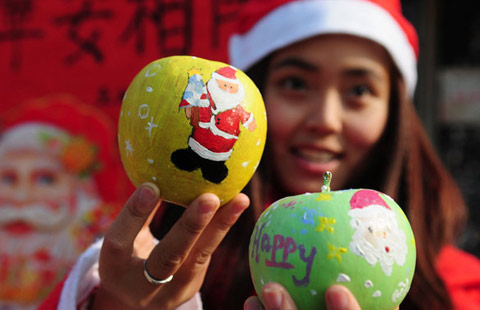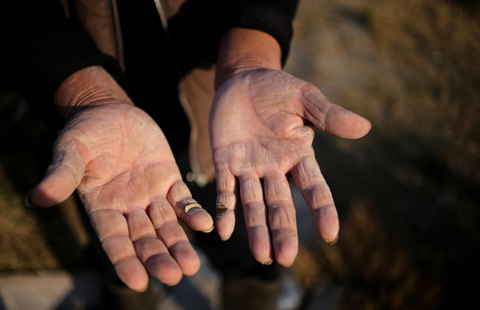Xinjiang as seen through eyes of US painter
Updated: 2014-12-29 04:02
By Zhang Yue(China Daily USA)
|
||||||||
Joy Bostwick, a 35-year-old woman from the state of Arizona in the United States, prepared for many dangerous circumstances when she decided in 2011 to move to Xinjiang Uyghur Autonomous Region to start her life as a painter there, after a terror attack two years earlier.
She then spent most of her life in the southern part of Xinjiang as an artist and photographer, with her husband and two daughters.
Two and a half years later, on Dec. 5, 2014, Bostwick opened her first painting exhibition in Beijing, entitled A Portrait of Xinjiang. All nine oil paintings selected from a total of 30 works showcases a tender portrait of local people's everyday and peaceful lives.
"My family and I live in an area where many Uyghur people also live. It's a place that many local people tell us "Hey don't go there, it is dangerous," Bostwick said. "But our lives there were very comfortable. Our neighbors were really friendly to us."
The exhibit, at the Beijing American Center, drew more than 100 people on opening night. More than 20 of them were Uyghurs.
"My first impression about Xinjiang was in the year 2000 when I read a story about the Shipton's Arch in National Geographic, which was breathtaking," Bostwick said.
She moved to China with her family in 2009, and lived in Beijing before relocating to Urumqi in 2011.
"I was hoping to move directly to Urumqi but my husband suggested that we stay in the city of Beijing for some time as none of us had ever come to China," she said. "Our time in Beijing helped us to learn more about the country and its people."
Bostwick finished her undergraduate degree at the University of North Arizona with a Bachelor of Arts in Spanish, but in her latter years in college, she found a great passion for art and changed her study to printmaking and oil painting. She has a big passion for ethnic culture and diverse landscapes, and many of her early paintings feature the lives of people in Latin America.
On her first visit to Xinjiang in 2009, Bostwick immediately fell in love with the place.
"I grew up in southern US and was genuinely attracted to natural scenery and a more rural life," she said. "Beijing gives more of a feeling as a modern city life."
The nine paintings selected for the exhibition portrays what local people's lives in Xinjiang looks like.
"Most of the time, I took photos during our travels, engaging with local people. Those oil paintings are based on my favorite photos, but I made very slight changes," Bostwick said.
This is the first time that her works were exhibited in Beijing. Her first exhibition was held in Urumqi in March for the International Women's Day.
During two and a half years in Xinjiang, the family traveled around most of the places in south Xinjiang where more Uyghurs live, and participated in many local festivals, such as the Corban Festival.
"We did hear a lot about how dangerous Xinjiang is, from the Internet and from people around us. And we came to Xinjiang after the riots in 2010, so there were quite some concerns about our stay there," she said. "There was a time that there were many police on the streets. But my husband and I have never really been in threatening circumstances."
Bostwick traveled most of southern Xinjiang, where many people remind them it was among "the most dangerous places in Xinjiang," including Kashgar and Khotan. Her two daughters, aged eight and 10, traveled along with them during each journey.
"I did not encounter anything really threatening," she said. "We learned there is a rule that foreign people like us are not allowed to stay at local people's homes overnight. So we live in hotels or go camping sometimes. We know it is important to obey the government rules in such areas, but besides that, local people were really friendly to us. I really love the place, and we hope to travel to the northern part of Xinjiang next year."
Contact the writer at zhangyue@chinadaily.com.cn

 Missing AirAsia plane maybe at sea bottom
Missing AirAsia plane maybe at sea bottom
 Yearender: Best selling Chinese films in 2014
Yearender: Best selling Chinese films in 2014
 Top 10 policy changes of China in 2014
Top 10 policy changes of China in 2014
 Families of MH370's passengers still hold out hope
Families of MH370's passengers still hold out hope
 SCH chairman sees bright future in Brazil
SCH chairman sees bright future in Brazil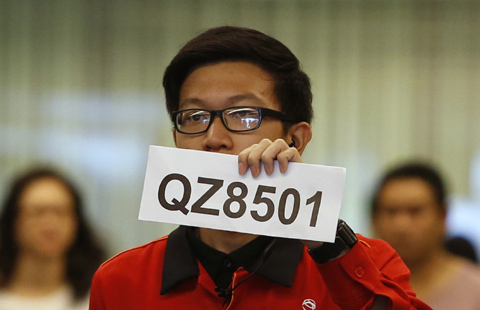
 Where did you go flight QZ8501
Where did you go flight QZ8501
 Trending across China: Never too old to learn
Trending across China: Never too old to learn
 Cartoons capture 10 major China stories of 2014
Cartoons capture 10 major China stories of 2014
Most Viewed
Editor's Picks

|
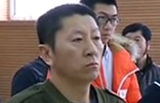
|

|

|

|
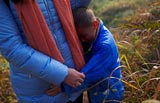
|
Today's Top News
Funeral set for Officer Wenjian Liu
China offers to help in search for missing AirAsia flight
AirAsia plane has tire problem in Philippines
Missing AirAsia plane could be at 'bottom of sea'
Deals planned to recover illegal assets from abroad
Parents seeking advantages send kids to US schools while young
Xinjiang as seen through eyes of US painter
China-Latin America relations strengthened in 2014
US Weekly

|

|


